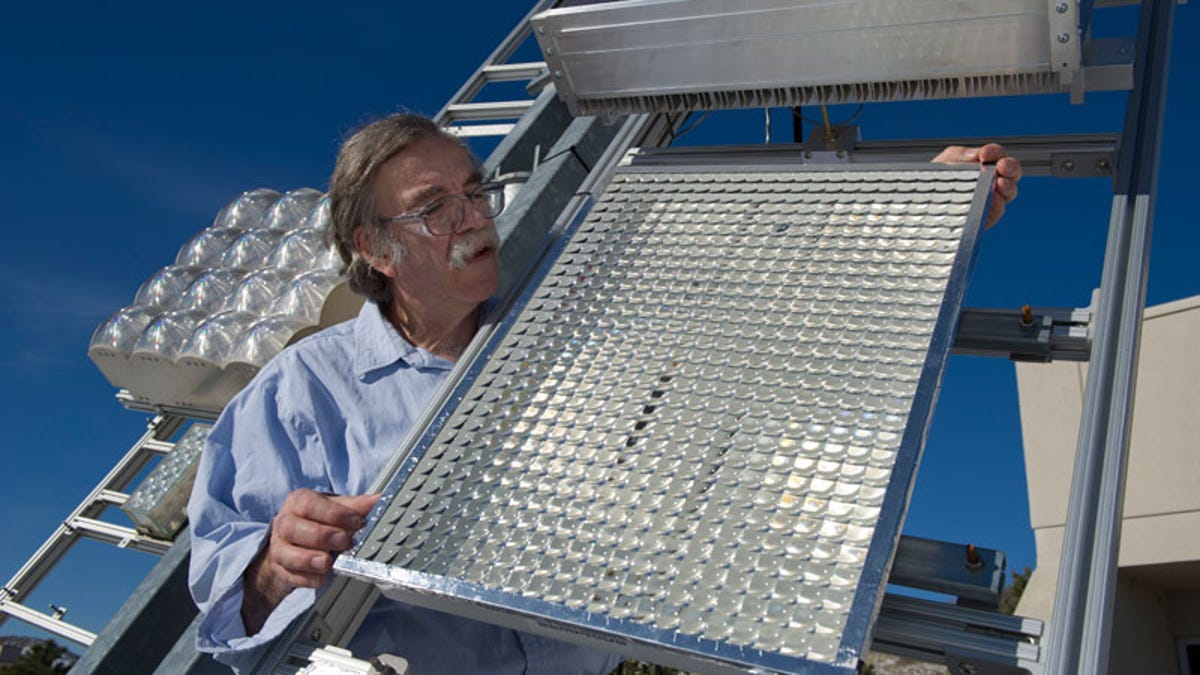Tiny solar cell dots printed for powerful array
Start-up Semprius blasts 1,000 suns worth of light onto dot-size solar cells assembled by machines to bring down the cost of concentrating photovoltaics.

A technique first developed to print flexible electronics has helped engineers at start-up Semprius reinvent the shape of concentrating solar technology.
The company's tiny solar cells, each a dot the size of a ballpoint pen tip, have been validated to convert 41 percent of solar energy to electricity, the National Renewable Energy Laboratory announced yesterday. Semprius is in the process of building a manufacturing facility in Henderson, N.C., to make concentrating solar arrays using its "micro-transfer printing" technique, according to the Department of Energy.
The semiconductor printing technique can be used for many applications, including improving LED lighting performance, better hard drives, or sensors for medical device.
But Durham, N.C.-based Semprius has first chosen to build a concentrating photovoltaic (CPV) collector that uses lenses to concentrate light 1,000 times onto its tiny solar cells. By having smaller cells, the company hopes to bring down the cost of concentrating solar power, which works in areas with lots of direct sunlight, such as the southwest U.S.
To build an array of "micro cells," Semprius grows a tiny semiconductor on a substrate and then a machine transfers those cells to a wafer. Additional layers are automatically added to the wafer so that a very efficient, triple-junction solar cell is constructed.
By essentially stamping micro cells onto a wafer, the technique allows for thousands of cells to be printed at once. It can also work with different semiconductor materials, including gallium arsenide and silicon, according to the company.
"This approach uses micro-cells and transfer printing to significantly reduce the use of materials in highly concentrated PV modules. And it provides a highly parallel method to manufacture the module, based on established microelectronics processes and equipment," Kanchan Ghosal, CPV applications engineering manager at NREL, said in a statement.
Once it manufacturers at large scale in the future, the company's target to build a system that generates electricity at under 10 cents per kilowatt hour, said vice president of business development Russ Kanjorski at Semprius.
Traditional CPV arrays concentrate light several hundred times with optics and mirrors onto high-efficiency, triple-junction cells. They are typically mounted on trackers to optimize the sunlight angle and optimize the performance. The technique does boost power from solar cells, but the optics and trackers do add cost. Traditional flat panel solar is far more prevalent for both residential and commercial solar although a number of CPV systems, including a 30-megawatt farm in Colorado, have been constructed in the U.S.
Semprius CEO Joe Carr projects the market will double for the next several years and grow to 10 gigawatts by 2020.
Development of the initial technology, which was transferred from the University of Illinois, was funded in part by the Department of Energy. Semprius has also raised venture funding and took an investment from Siemens in June.
Its North Carolina plant is projected to start operating next year with a capacity of making 5 megawatts worth of panels. The state and local agencies invested $7.9 million for construction, according to NREL.
Updated at 12:45 p.m. PT with projected solar generation costs.

